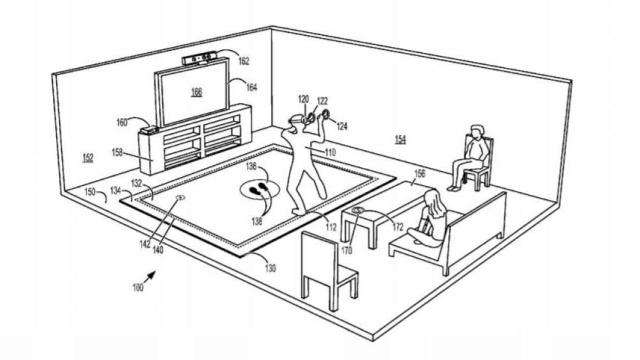Microsoft might be working on a virtual reality mat to, at least in part, keep you from getting clotheslined by your coffee table yet again while ostensibly blinded by a VR headset. The company calls it a “virtual reality floor mat activity region” in the patent application it filed to the U.S. Patent and Trademark Office this week.
But any old carpet could visually block off where you’re going to be throwing yourself around willy nilly. This patent, first spotted by Variety, describes something a bit more complicated.
Microsoft’s mat would potentially house a bevy of tech capable of influencing your VR experience while also keeping you safe from the dangers posed by surrounding furniture. Built-in “fiducial markers” and “spatially distributed pressure sensors” would communicate with the VR console to pinpoint your physical location on the mat, data that could then be used to help shape the virtual world around you.
The patent also mentions the possibility of putting “vibration devices” in the mat to make it, well, vibrate. Which I suppose would make for some kind of 4-D experience when paired to whatever is happening on the headset. Microsoft’s patent goes on to list multiple configurations of possible VR mats, including one that would allow for some kind of customisation options so you can personalise your play space.
Most interesting, though, is the shout-out to Microsoft’s defunct Kinect, a peripheral motion sensor used to play certain games on its Xbox 360 and Xbox One consoles. Like the PlayStation Move, it was basically the company’s attempt to get in on the lucrative motion-controlled gaming market that Nintendo’s Wii was dominating at the time.
One of the images included in the patent shows the proposed virtual reality mat in a living room, and the spitting-image of a Kinect is clearly visible on top of the TV. Microsoft also directly mentions the mat’s potential to be used for gaming later in the patent:
“In some examples, [the] computing device may take the form of a gaming console, and [the] HMD device and peripheral control devices may be peripheral to the gaming console.”
To be fair, though, the patent mentions a lot of possible VR computing devices, including “personal computers, server computers, tablet computers, home-entertainment computers, network computing devices…” and so on. It even throws smartphones and wearable devices out there, so Microsoft may have simply been casting a precautionarily wide net.
Released in 2010, the Kinect never quite caught on with gamers the way Microsoft had hoped (a.k.a. like the Wii) and so the company discontinued it in 2017. Surprisingly, though, it eventually developed such a dedicated following among developers and hackers that Microsoft announced its return last May, except this new iteration sports a better camera and Microsoft’s cloud-based AI technology. Maybe the company was playing a long game with the Kinect’s comeback. Stranger things have happened in the year off our lord 2019.
